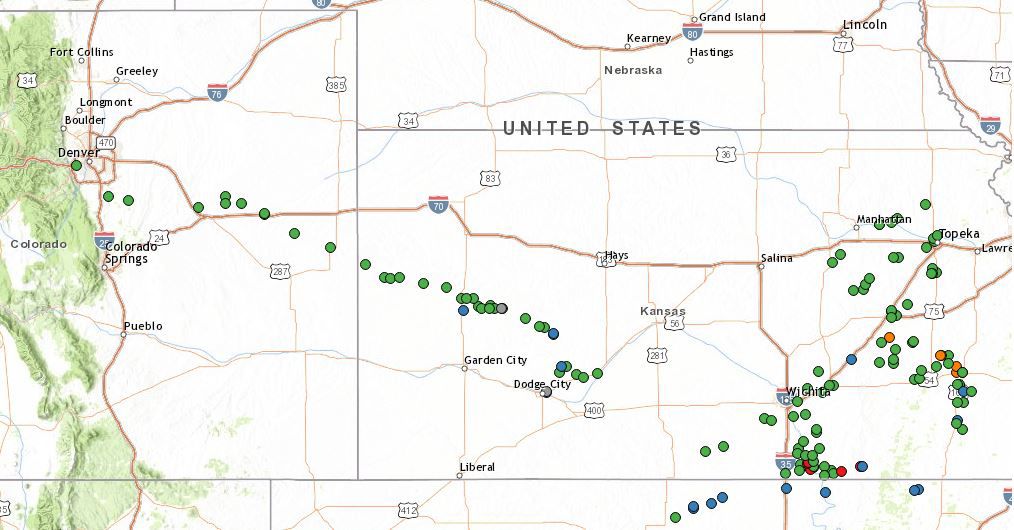Hail dots region, leaving some farmers in its path to question their wheat harvest prospects

Marc Ramsey has learned over the years never to doubt wheat.
The Scott County, Kansas farmer has seen the hardy crop survive through many adversities, including a 17-inch snowstorm in May 2017.
But, while assessing the damage the next morning after hail and high winds ripped through the area, “I’m not sure I’m confident this time,” he said.
Storms hit Kansas and surrounding states the evening of May 14. It brought much-needed rain to some areas where extensive drought has lingered for several months. But in a swath that runs from Kinsley, Kansas, to Elizabeth, Colorado—just north of Colorado Springs—it also meant hail, according to the National Weather Service.
Ramsey estimated his farm received golf ball- to baseball-sized hail. Besides damaged wheat, he found broken out windows and was surveying the damage to his tractors and implements.
"I couldn’t even hear the wind over the hail," he said, adding wind speeds topped 70 mph.
The weather service received reports of 1-inch hail at Spearville and 3-inch hail at Weskan. In Colorado, estimates ranged from 1 to 3 inches.
Eastern Kansas also was dotted with hail, with most of the reports an inch or smaller. In south-central Kansas, a tornado was spotted near Arkansas City.
Near the ghost town of Amy in eastern Lane County, Kansas, farmers Vance and Louise Ehmke were driving the area Tuesday morning, measuring damage to their seed wheat production. Their crop insurance agent called that morning, asking for a report.
Hail occurred in a 4- to 5-mile swath along Kansas Highway 96, Louise Ehmke said. At their farm south of Amy, they received pea-sized hail and .75 hundredths of rain.
Farther north, however, the damage was more extensive. Some fields are 50 to 100 percent losses, Vance Ehmke estimated. One field they drove by was mowed down to a half-inch tall.
“It’s painful to look at,” Louise Ehmke said.
Another field looked better at what Vance figured was a 75 percent loss.
“It’s still effing bad,” he said.
“There is going to be variable damage,” Vance said. “Some of the stalks are clean breaks and that is totally gone and some are damaged and bent over and they could recover.”
In all, Vance thought he had lost six quarters—all of which were in seed production.
“How on earth can you get hailed out in the worst drought in 144 years?” he asked. “Stubble fields are also mowed flat. It looks like a carpet of straw cover them.”
He said he wondering what to do with the hailed out fields.
Sign up for HPJ Insights
Our weekly newsletter delivers the latest news straight to your inbox including breaking news, our exclusive columns and much more.
There is one upside, he said. There will be less income tax claimed.
The wheat is just starting to head in the region, he said. They weren’t expecting a bumper crop, but not a bad one either.
“It was going to be below normal, but it was not the end of the world,” Vance said.
Ramsey and the Ehmkes have crop insurance, but neither have hail insurance. Ramsey, who came back to the farm in 2011 to farm with his dad, Craig, said he hasn’t experienced much hail in his career.
Ramsey said despite the drought, his area was in an oasis of sorts. He planted one field of wheat before the fall rains. It hung on, and he had expected a good wheat crop—good enough he even planned to enter a section of the field in the annual wheat yield contest.
He might have to ditch that idea this year, he said. What he is seeing as he inventoried the farm isn’t pleasant.
“I don’t know what to expect now,” he said, later adding, “I thought we had some good shots to get some good yields here. All we had to do was get it to harvest.”
Yet, like an optimistic farmer, he hasn’t given up his wheat.
"There is some that didn’t break," he said. "We’ll wait and see if it recovers. Most guys are calling the insurance guy."
Amy Bickel can be reached at 620-860-9433 or [email protected].



